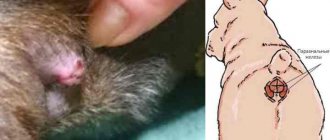Mastitis in dogs can develop in any unsterilized dog. Both pregnant (or already whelped) females and non-pregnant females are susceptible to pathology. The disease develops quite quickly and causes the dog significant discomfort and pain.
Let's look at why mastitis develops? What are the main signs of the disease and how to treat the disease? Is it possible to help a dog at home?
Mastitis is a pathological inflammatory process in the mammary gland of a dog. Due to the special physiological structure, inflammation in the gland can develop quite quickly, turning into more severe forms. Therefore, it is important not to start the process and continue to treat it to the end.
Classification of mastitis
Inflammation can occur in two forms:
- acute – symptoms are clearly expressed, a rapidly developing process;
- chronic - symptoms may appear periodically, usually some time after estrus.
According to the nature of the flow, the following types are divided:
- serous (pathology begins in the parapapillary area, often caused by microcracks in the nipples);
- catarrhal (the ducts and milk alveoli are directly affected, developing after serous, as an ascending process);
- purulent (when bacterial microflora is involved in the process of inflammation);
- gangrenous (severe pathology when gangrene of the mammary gland may develop);
- abscess (appearance of abscesses);
- phlegmonous (spread inflammation throughout the mammary gland);
- hemorrhagic (due to numerous hemorrhages, the color of the milk takes on a bloody tint).
Common myths about false pregnancy
There are many misconceptions among novice and even experienced dog breeders about the behavior of dogs during false pregnancy and the possible complications of this disorder.
Here are the most common ones:
Thus, it is better for every dog breeder to know well how false pregnancy manifests itself, how long the disease lasts, and what needs to be done in extreme cases. If you are not sure about your pet’s health, it is better not to waste time and immediately contact a veterinary clinic.
In the video, a veterinarian talks about false pregnancy in dogs.
It happens that liquid is released from the dog’s nipples. This is a natural phenomenon, but sometimes an alarming sign for the health of the female. Based on their nature and frequency, the primary picture is established, and with the help of tests, the diagnosis is clarified.
Before visiting a doctor, remember their color and quantity, time of appearance, whether they are released on their own or after pressure, and whether there are additional symptoms.
Causes of false pregnancy
First you need to understand where this phenomenon in the dog’s body comes from. The fact is that some kind of hormone failure begins in the pituitary gland. Namely, prolactin, the hormone responsible for lactation in the mother, begins to be actively produced despite the absence of pregnancy.
And all this happens for this reason. The dog belongs to the canine family. Living in a pack, canines have only one alpha female, who gives birth to puppies. All other females must support their main female in a crisis situation and feed the babies with their milk. The alpha female is required to hunt and bring food for herself and her cubs. And if she is absent for a long time, then the other females look after the puppies. If the alpha female dies, her puppies are raised by other dogs. It turns out that false pregnancy is a natural phenomenon, which in the wild is a necessary condition for the survival of the pack.
Owners of several dogs can confirm that bitches often adapt to each other and go into heat at the same time. This is a sign of flocking. During ovulation, when eggs are released from the burst follicles, a corpus luteum begins to form, which in turn produces the pregnancy hormone - progesterone. And the high level of this hormone lasts for 60-63 days, the time during which the intended pregnancy lasts. Even if the dog is not pregnant, the corpus luteum does not go anywhere all this time. Then it gradually dwindles. But all the hormones that are released during pregnancy are there. The only difference is that there are no puppies.
The phenomenon of false pregnancy does not only occur in dogs. It also appears in rabbits, cats, ferrets and other animals. However, in dogs, as a rule, it is more pronounced. What manifestations can occur during a false pregnancy?
Causes
The main causes of the inflammatory effect of the mammary gland in a dog:
- Injury to the mammary glands - cuts from the claws or teeth of other animals or puppies during feeding. Puppies have very sharp baby teeth. When injured, pathogenic bacteria penetrate through microcracks into the breast tissue and cause infection.
- False pregnancy - occurs as a result of hormonal imbalance after estrus, during which there was either no mating, or there was one, but did not end in fertilization. The concentration of the hormone progesterone decreases and at the same time the level of another hormone, prolactin, increases. Milk is produced in the mammary glands of a nulliparous dog.
- Early weaning of puppies from a nursing mother. Milk accumulates in the gland, stagnation, fermentation and inflammation occur.
- Chronic processes in the female reproductive organs.
- Entry of pathogenic bacteria and viruses into the mammary gland through lymph or blood.
- Blocked milk ducts.
- Stress.
By
What is the nature of false pregnancy?
There is an opinion that false pregnancy in dogs is inherent in nature. For example, if one pregnant female dies in childbirth, her puppies can be raised by another, thus maintaining balance in nature. Indeed, there are quite a lot of cases when newborn puppies are fed by another bitch, although this phenomenon is more likely to be observed in animals leading a wandering lifestyle.
From a medical point of view, false (imaginary) pregnancy is a psychophysiological disorder. That is, a hormonal imbalance occurs in the animal’s body. This can happen to every bitch that has reached puberty. Sometimes something similar is observed even in individuals who are completely devoid of reproductive organs, and also in whom only the uterus was removed or parts of the ovaries remained after ovariectomy.
Pseudopregnancy develops during the period of metestrus, when estrus has already ended and the corpus luteum continues its vital activity for some time. The corpus luteum is an endocrine gland that is responsible for the production of pregnancy hormones. It is this that signals the brain that the body is ready to bear babies, even if fertilization has not actually occurred. As a result, the body begins to prepare for the upcoming “birth” and feeding of the offspring.
The most common causes of pseudopregnancy:
- Bitch with problems in the reproductive system (including in animals with partial sterilization).
- Keeping the bitch in the same room with lactating and pregnant females.
- Mating to a castrated or sterile male.
- Psychophysiological disorders in animals.
- Hormonal imbalance.
Pseudopregnancy lasts from two to four weeks. Sometimes the period of “gestation” of puppies is prolonged.
Why is there brown discharge from the nipple?
This color indicates the presence of blood in the discharge. The reason is:
- infection in the tract;
- mechanical injuries;
- even oncology.
It doesn't matter if the dog is nursing or not, it's worth seeing a doctor. Alarming symptoms: the presence of pain when the mother runs away from hungry puppies, swelling, asymmetrical hard formations, an unpleasant odor of brown discharge.
If it is an infection, antibiotics are prescribed. Then feeding the puppies will have to stop and switch to manual feeding from bottles. Injuries, especially in lactating bitches, are normal: puppies may bite the nipple. They heal on their own in a few days. But if the discharge becomes more numerous, its color becomes more intense, the bitch becomes lethargic, apathetic, and whines - show her to the veterinarian.
Also, blood impurities cause papillomas in the ducts and ectasia. In these cases, an integrated approach is required: drug therapy and sometimes surgical intervention. Removal of the ducts is carried out using nanosurgical methods; the operation itself does not last long and is absolutely safe.
First aid for a dog during an imaginary pregnancy
If, at the end of the “pregnancy” period, the dog begins to produce milk, it is necessary to exclude all dairy products from its diet, and also reduce fluid intake several times. If these steps fail to prevent incipient mastitis, you should immediately seek help from a veterinarian. Alarming symptoms:
- The appearance of inflammatory foci and the formation of purulent wounds.
- Excessive compaction of milk bags.
- Increased body temperature.
- Redness of the chest.
It is necessary to reduce the amount of protein consumed per day, as well as reduce the portion. Partially replace the meat with grains and vegetables. If the dog eats dry food, then the daily ration should be reduced by a third.
Attempting to help with lactation by pumping may result in additional stimulation of milk production. In addition, it is important to remember that any massage actions can lead to sad consequences, for example, such as stagnation. It is advisable to suppress milk production with the help of special medications, which are prescribed exclusively by a veterinarian.
If a bitch constantly licks her nipples, you need to put a special blanket on her.
To distract the animal from unnecessary thoughts, you need to clear the space around as much as possible, temporarily eliminate other pets, and remove small toys that a bitch preparing for motherhood can accept for her puppies. It is advisable to make the bed as small as possible so that there is no room left for the “future offspring”.
You can use sedatives, such as Feliway, which do not cause side effects.
Homeopathic medicines perfectly eliminate the undesirable consequences of false pregnancy (it is strictly not recommended to use them without a doctor’s prescription).
There are cases when an imaginary pregnancy requires serious treatment using hormonal drugs. They can only be prescribed by a veterinarian. Independent use of such drugs is fraught with serious consequences, including malignant neoplasms.
Symptoms
How can you tell if your dog has mammary problems? Symptoms of inflammation may vary depending on the form and nature of the course. Sometimes the initial stages may not even be noticeable to the dog owner. As inflammation develops, signs become obvious.
- apathetic state - the dog is lethargic, lies down more;
- appetite is reduced or completely absent;
- increase in the volume of milk packages;
- local redness of the mammary glands (with a gangrenous appearance, the glands may acquire a purple tint);
- local increase in temperature of milk packages;
- dense and painful mammary glands when touched;
- general increase in the body (characterized for severe forms - purulent, gangrenous, phlegmonous);
- when pressed, discharge of watery milk or pus with blood from the nipple (purulent and hemorrhagic mastitis).
Only a doctor can determine the specific type of inflammation when examining the animal.
When does it occur and for what reasons?
One of the reasons for the manifestation of this condition is considered to be the periodization of the appearance of puppies in the pack . In nature, everything is arranged in such a way that the females of one pack are in heat (estrus) and give birth to puppies during the allotted period.
In order for the maximum number of individuals to survive, even in unfertilized females in the flock, the mechanism of false pregnancy is activated. Lactation of such bitches allows them to participate in the process of feeding other people's offspring . False pregnancy usually appears 4-9 weeks after estrus.
Signs
We will analyze in detail all the manifestations of false pregnancy with a description of the reasons .
- Enlargement and swelling of the mammary glands. It is caused by the secretion of prolactin, a breastfeeding hormone that is released during true pregnancy so that the mother can feed her offspring.
- Changes in the pigmentation of the mammary glands are also caused by the release of prolactin and changes in the structure of the epithelium in the gland area. The skin becomes softer and more porous so that the puppy can drink milk without difficulty.
- The formation and secretion of milk from the mammary glands, as a consequence of the previous two factors.
- Swelling of the loop and the appearance of discharge from it. Why does this happen: when the concentration of prolactin, according to the daily cycle, falls, and progesterone increases, since these two hormones have a feedback mechanism.
- Loss of appetite. The mother's body is under stress and all resources are directed towards raising the offspring. This lowers the priority of all other life systems.
Changes in behavior
- The mother is setting up a den for the offspring, because she is sure that the puppies are about to appear.
- Sometimes he drags soft toys, pillows, and dolls into the “den” and begins to play with them. This is how she prepares to become a mother and takes on the role of a nurse, tucks them under her, and warms them up. Sometimes there is milk secretion.
Completely loses interest in other areas of life (walks, games, training), becomes apathetic.- Sometimes a nervous state . Depending on the character and temperament, in the most difficult cases the dog may even begin to defend its “den” and the dolls, which it mistakes for puppies.
How does pathology manifest itself?
The disease is characterized by a rather striking manifestation. It is easy to diagnose. There are general and local symptoms. After analyzing them, the veterinarian prescribes treatment.
After diagnosis, treatment is prescribed.
General symptoms
General signs of pathology include:
- increase in general temperature;
- decreased appetite;
- apathy;
- decreased interest in games.
During illness, the dog has no appetite.
The dog often sleeps, its activity drops sharply.
Local symptoms
- There is an increase in the size of the affected mammary gland packages.
- On palpation they seem dense and hot.
- The dog may whine or yelp while feeling the glands.
- Sometimes pigmentation of the skin is observed.
When palpated, the dog feels pain.
The catarrhal form is characterized by the appearance of whitish flakes when the nipples are compressed. Their shade can vary to brown-green.
The purulent form is characterized by the appearance of yellow or brownish liquid. Sometimes a thick gray mass appears. Bloody threads are often mixed in.
Treatment of mastitis in dogs
Treatment of inflammation in dogs must be timely and correct. It is better for the dog to be examined by a doctor in any case and leave recommendations for the care and treatment of the dog.
What is the danger of mastitis?
The disease can progress very quickly without prescribed treatment, with further severe consequences for the body. In addition, milk from the inflamed gland is dangerous for puppies . Especially if there are a lot of puppies, it is impossible to make sure that the babies do not suck on the sore nipple.
Untreated mastitis tends to degenerate into benign and then malignant neoplasms.
Important!
Breast tumors are quite aggressive - they grow quickly and are characterized by a high level of metastasis.
How to help a dog at home?
Only mild forms of mastitis can be treated at home. For periods between feedings, the female is wearing a protective blanket to avoid unnecessary injury and licking. A protective collar is also suitable for these purposes.
While feeding the puppies, the nipple on the affected gland is sealed with a bandage. After completion, a light massage is performed from top to bottom. The nipple is wiped with a damp cloth, the milk is carefully expressed and disposed of. Then the skin is treated with camphor alcohol using a cotton swab. The gland is covered with gauze and a blanket is put on.
By
Treatment
How to cure mastitis in a dog? It is necessary to treat together with a veterinarian, no treatment with folk remedies, since in almost 100% of cases microorganisms are to blame! And without the use of antibiotics, it will not be possible to cure a dog with mastitis at home! And only the veterinarian decides what injections are needed for an animal with inflamed mammary glands.
First aid at home
If mastitis in a dog is just beginning, then you can start treatment at home: you can slightly warm the gland (camphor oil is excellent for warming the gland with mastitis in a dog), express milk from the diseased gland (not completely!) and tightly bandage the affected lobe .
But remember that heating is allowed only for catarrhal or serous mastitis!
In case of purulent, phlegmonous, abscessing and gangrenous conditions, it is strictly forbidden to heat inflamed tissues! Heat will only accelerate the spread of inflammation and provoke a “breakthrough” of the abscess.
Medicines
Before using antibiotics to treat a dog with mastitis,
it is necessary to determine which drug the microorganisms are sensitive to. Unfortunately, titration takes more than one day, so broad-spectrum antibiotics are prescribed for the first time.
If improvements are not observed within three days, then the research results will come in handy (the most effective antibiotic will be found that will kill pathogenic microorganisms). You won’t be able to cope with the selection method yourself; you’ll just trigger the disease (even to the point of sepsis and death of the animal).
It would be nice to strengthen your immune system.
For this purpose, immunostimulants and modulators are prescribed. It would be good to take the milk from the affected lobe to the laboratory (good clinics have such departments) so that a culture can be done. This way the veterinarian will know which bacteria are to blame for the inflammation. If it is staphylococci, the doctor will prescribe antistaphylococcal gamma globulin. And the pet will begin to recover quickly.
Antipyretics, antihistamines, vitamins, and painkillers will help. But without antibiotics it will not be possible to achieve a complete recovery.
If everything has gone very far, treatment of a dog with mastitis was started too late or did not give positive results, then you will have to resort to surgical intervention. By removing the affected gland, you will remove the “site of infection.” And the chances of recovery will be much greater.
If the gland in a bitch with false pregnancy is inflamed, then antibiotics will be required, as well as drugs that stop lactation. Be sure to bandage the glands.
How and with what to treat?
Most veterinarians recommend antibiotics and other medications, but pre-medical treatment for mastitis can be used.
Sick dog
Important! Treatment of mastitis in a dog at home is only suitable for primary signs of inflammation and the absence of ulcers; in other cases, a visit to a veterinarian and drug treatment is required.
Inflamed mammary glands can be treated with 10% camphor oil intended for animals. Milk from the inflamed lobes is expressed twice a day to avoid stagnation, and a tight bandage is applied to them. Puppies should not have access to the affected areas.
The manifestation of mastitis can be aggravated by the fact that a dog with false pregnancy syndrome will try to stimulate the nipples. In this case, the veterinarian will prescribe hormone therapy or a mild sedative for the dog in an attempt to curb the behavior.
First aid for false pregnancy
First of all, the animal needs to be closely monitored. You should not strive to organize mating in the hope that all the symptoms will go away immediately. Often such a decision can lead to complications.
In this case, you can try to provide some kind of first aid by taking the following measures:
- Reduce the daily portion by 15-20%.
- Reduce water consumption - give water 3 times a day and do not feed liquid food.
- Discreetly remove everything that the dog brought into its “nest” and replace the bedding.
- Increase the time of walks, try to pay more attention to the animal, even if she is “protective”, assuming that she is protecting her fruits.
- If the dog's mammary glands hurt, and their surface has become rougher, it is permissible to apply a compress at night. Use honey and bread crumb or aloe juice on a cabbage leaf.
It is important to understand that no independent treatment with pills, hormonal drugs or other medications is allowed, as this can lead to complications. If these measures do not help (for example, within a week), you should immediately contact a veterinarian.
In some dogs, during false pregnancy, the mammary glands become enlarged; in this case, you can apply a compress to them.
Attention. Milk often appears during a false pregnancy, and the bitch tries to express it herself. You should not express it yourself, but it is better to put a blanket on the dog to prevent this process.
Prevention of mastitis
- The surest way to prevent mastitis is to sterilize the dog if further breeding is not planned.
- For whelping and whelping females, it is important to strictly observe hygiene - regularly change the bedding, examine the mammary glands after each feeding, and periodically wipe the nipples with a damp cloth.
- Timely treatment of wounds, cracks and scratches on the nipples and mammary glands to prevent the entry of harmful microorganisms.
- Nail trimming for puppies from 7-14 days of age.
Video:
Views: 976
The appearance of colostrum during pregnancy
A dog that is ready to give birth produces milk from its nipples already in advance. This means that all the necessary physiological changes in the body have already occurred. Motherhood should go well. Colostrum will soon appear - a translucent white liquid that precedes the arrival of milk itself in the nipples.
The glands may swell slightly, but they should not become very hard. The dog feels well, licks himself a little, and shows no anxiety or symptoms of fever. The presence of a dangerous pathological process that began during pregnancy can be indicated by bloody, brown and rotten-smelling discharge, red and cracked skin.
False pregnancy in dogs and causes
The physiological changes occurring in the dog’s body have not yet been explained. There are many assumptions regarding the origin of this pathology. The main one is based on the fact that false pregnancy syndrome in dogs occurs as a reaction to hormonal imbalance after the end of estrus. During estrus, the level of lactogenic hormone increases.
The causes of pathology may be the following:
- not constant breeding activity, in other words - mating;
- purulent inflammatory processes that occur in the mammary glands - metritis, pyometra, etc.;
- increased levels of hormones produced only during pregnancy.
During the third phase of the estrous cycle, the production of corpus luteum begins, which creates the pregnancy hormone. If fertilization is successful, the production of other hormones begins, but if it fails, the corpus luteum remains in the female’s body for 70 days. It is during this period that the pregnancy hormone continues to be produced.
Another reason could be an unsuccessful pregnancy - resorption or death of the embryos. In other words, the puppies died at the developmental stage, but milk continues to be produced, since the dog is conditionally pregnant. Often, the risk of this pathology continues for 4 weeks of pregnancy. The risk is a consequence of violations in the conditions of keeping the female, incompatibility and due to poor nutrition.
Symptoms of false pathology
The reason that the dog began to produce milk is precisely false pregnancy syndrome. The pathology can be mild or severe and cause various symptoms.
Physiological manifestations:
- the stomach is rounded;
- nipples swell;
- apathy;
- milk is released from the nipples;
- discharge occurs from the swollen loop;
- lack of appetite and refusal to eat;
- nausea.
- Possible worms.
Behavior:
- change in gait - the female begins to fall on her hind legs;
- shows concern and even fear, often ignoring the environment;
- begins to fawn over the owner, asking for more attention;
- often hides in secluded corners of the room;
- As the deadline approaches, aggressiveness increases.
The manifestation of a change in the behavior of the animal is considered the most striking sign of a false pregnancy. Even a previously friendly dog becomes wild towards its owners. It is impossible to say exactly what exactly influences this: the awakened maternal instinct or aggression arises due to the painfulness of the changes occurring in the body.
False contractions are considered a particularly severe symptom - the process is real, complicating the provision of assistance to the dog. The animal really feels the desire to give birth, contractions begin and continue for several hours, aggravating the situation.
Pathological processes in which the discharge is abnormal
Vaginitis, pyometra, endometritis, tumor processes in the genital tract - this is not a complete list of all possible diseases that pose a danger to the pet’s health and are accompanied by unpleasant discharge and a pungent odor. Only a specialist can accurately diagnose the disease and prescribe appropriate treatment.
Vaginitis
is an inflammation of the vaginal mucosa. With this pathology, minor discharge is observed, the animal licks itself a little more, so most often the owner is not always able to recognize the disease in a timely manner. It is for this reason that vaginitis is often confused with normal estrus. The progression of this pathology entails complications that can seriously deteriorate the dog’s health.
There is also a rarer vaginitis - juvenile
. Puppyhood or prepuberty to puberty. This vaginitis is characterized by inflammation of the vaginal mucosa, occurring due to endocrine disorders. This is a disease of young females before the onset of puberty, which is manifested by a transparent mucous discharge from the vagina, often with a whitish tint or a thick yellow-green secretion, the abundance of which may vary from dog to dog. Vaginal discharge may be itchy, and dogs may lick the genital area vigorously. It is extremely rare that the disease leads to a slight disturbance in the general condition, sometimes with an increase in temperature. To establish an accurate diagnosis, cytology of a vaginal smear is required, since it has a characteristic picture for this pathology. According to the results of cytology, in the case of a bacterial infection, additional antibiotic therapy is required.
Endometritis
is also characterized by inflammatory processes of the uterine mucosa. The disease occurs in acute or chronic form. Inflammation of the endometrial walls in bitches at the initial stage does not have pronounced symptoms or strong discharge and is associated with hormonal imbalance. As a result, the mucous membrane of the uterus thickens, and increased accumulation of secretions occurs. The secretion is a favorable environment for infection, so the discharge becomes purulent. With chronic endometritis, the only symptom may be the inability of the bitch to become pregnant or bear offspring. Most often, no discharge is observed. The general condition of the dog is quite good.
Pyometra
is a purulent inflammation of the uterus in bitches. It is characterized by the accumulation of purulent contents in large quantities in the body and horns of the uterus. This disease has two forms: open and closed. The open version is easier for the dog, since the pus comes out through the open lumen in the cervix. When the pyometra is closed, pus gradually accumulates in the uterus, which leads to intoxication of the body, uterine rupture and death of the pet. But you need to understand that an open form can easily turn into a closed one. The animal may experience a deterioration in its general condition, fever, vomiting, refusal to eat, etc. The disease can be fatal. The diagnosis is made based on the collected medical history, general blood test, ultrasound and vaginal smear cytology. Most often, treatment is surgical, but if the dog is in good health and the tests are not too bad, drug therapy is possible.
Tumor processes in the genital tract
is also a common pathology that leads to the appearance of discharge and deterioration of your dog’s condition.
There are tumors of the ovaries, less often of the uterus, there is also venereal sarcoma, which affects the mucous membrane of the genital organs.
Venereal sarcoma
(transmissible sarcoma, i.e. sexually transmitted) is a malignant neoplasm that affects the mucous membranes of the genital organs in dogs. It occurs in females and males used for breeding, or most often in street animals. Owners notice drops of blood coming from the external genitalia, which are often mistaken for estrus. The tumor resembles “cauliflower” in appearance and is localized mainly in the mucous membrane of the genital organs, but mechanically can be transferred to the mucous membranes of the mouth, nasal cavity, and eyes. Infection occurs during mating of animals.
Prevention
If you have encountered a false pregnancy in your dog at least once in your life, then this is a reason to think about planned sterilization. This is the main method of prevention that will help keep your pet healthy and prevent subsequent problems.
If the animal is of breeding value and you need to get offspring from the bitch, then before mating it is recommended to check the dog for the absence of inflammatory processes in the body, rule out problems with the reproductive organs and monitor hormonal levels. It is also important that the male is healthy and tested for offspring.
How to avoid false pregnancy? What to do if it comes? How to recognize? How long does it last and how does it go? These are the most common questions asked by owners of female dogs. Only a highly qualified veterinarian-reproductologist can answer them correctly and in full. He will help you calm down, explain how it manifests itself and what to expect, as well as how to help your four-legged friend. Under no circumstances should you self-medicate or test folk remedies on an animal. They are, in most cases, useless or can make the situation worse. The surest solution in such a case is radical sterilization, that is, the immediate removal of the uterus and ovaries.
Physiological processes in which discharge is normal
Estrus (estrus)
- stage of the reproductive cycle. This is a natural process that indicates that the female has reached puberty.
The timing of puberty often depends on the size of the breed. In miniature (small) dogs, the first heat begins earlier, in large dogs - a little later. The first heat occurs at 6-12 months, sometimes at 1.5 years. If the dog does not have it by the age of 2, then some kind of pathology is possible, and a doctor’s consultation is required. On average, the duration of estrus is 20-22 days. The exact cycle will be established in the female only after several heats. Dogs usually come into heat twice a year, and in some animals it happens once a year. If it occurs more often, there may be a risk of hormonal imbalances and a consultation with a specialist is also required.
The dog's reproductive cycle consists of 4 stages:
- Proestrus (pre-gesture)
lasts approximately 7-10 days.
At this time, the first signs of estrus in the dog appear: blood flow to the genitals increases, the loop swells, and the first bloody discharge appears. But the dog is not ready for mating, since ovulation has not yet occurred. And her behavior is already changing. During this period, dogs can use panties for estrus.
- Estrus (actually estrus),
sexual heat.
During this period, ovulation occurs. The cellular composition of the discharge changes, and in order to determine the dog’s readiness for mating, a smear is performed at the veterinary clinic to determine readiness (i.e., 7-10 days after the first signs of estrus). The discharge itself at this time may also be different for different dog breeds. In some individuals they may be practically absent, in others they become light pink. During the period of estrus, the bitch begins to allow male dogs to approach her: she raises her pelvis, tightens the loop, withdraws her tail and freezes.
- Metaestrus (end of estrus).
The reddish, light pink discharge disappears, the loop decreases in size. The female stops allowing male dogs to approach her. If pregnancy does not occur, the body returns to its normal state over time.
But dogs still have elevated levels of progesterone, and sometimes, regardless of whether fertilization has occurred or not, some bitches develop a false pregnancy, which most often goes away on its own and without consequences. But if suddenly there is a thickening of the mammary glands and a refusal to eat, you should consult a doctor. Drugs are prescribed to stop lactation and eliminate the symptoms of false pregnancy.
- Anestrus (sexual rest)
is a period of absence of estrus.
The average duration is 100-150 days.
If estrus is too long (protracted), short, frequent or rare, you should consult a doctor.
Discharge that appears immediately before childbirth (it lasts 3-4 days or a little more) and after labor is also considered normal.
Discharge from a loop in a pregnant dog is a pathology!
That is, any discharge during pregnancy is considered abnormal and can be dangerous. Of course, very slight discharge is present during pregnancy, but it is so small that the owner should not notice it. If there is visible discharge, you need to consult a doctor and undergo an ultrasound. This will help you monitor the course of your pregnancy and find out the approximate number of fetuses.
24-48 hours before birth, sticky and thick discharge of a whitish or grayish color appears. They indicate that the so-called “plug” has come out and the birth process has begun. If you notice that the dog’s discharge before giving birth has a sharp putrid odor and a dark color (green, yellow, brown), if the animal’s body temperature has increased (after all, the temperature normally decreases before giving birth), the female should be immediately taken to the veterinarian and have an ultrasound performed.
After childbirth, the discharge in the first 2-3 days has a brownish color, then it gradually lightens and becomes transparent or with a slight pink tint. The duration of discharge varies from dog to dog. It depends on the size of the dog itself and the number of puppies. Usually, by the end of the maximum 2nd week of the postpartum period, the discharge becomes thinner and stops. That is, the involution of the uterus has occurred - its return to its prenatal size.
Subinvolution of the uterus is also possible - disruption or slowing of the reverse development of the uterus to normal (prenatal) sizes. It is rare and most often occurs in young dogs. Accompanied by prolonged (more than 3-4 weeks) sticky discharge, sometimes mixed with blood. This condition can lead to the development of endometritis (inflammation of the lining of the uterus), and with the addition of a bacterial infection and transition to a more dangerous process - pyometra (purulent inflammation of the uterus). If you experience any similar symptoms, you should consult a doctor.
On the 3-4th day after birth, it is recommended to perform an ultrasound of the uterus, since there is a great danger that the closing cervix may not allow large particles of tissue to pass through (for example, the placenta or placenta, perhaps even an unborn puppy). In this case, additional therapy and dynamic ultrasound are required.
TRUTH AND LIES ABOUT FALSE PREGNANCY.
False pregnancy is not a disease. This condition can be described as “physiological pseudopregnancy”, since every non-pregnant bitch periodically experiences characteristic symptoms to one degree or another. There is a theory that false pregnancy in dogs is a primitive way for bitches to feed other puppies in a given pack of dogs if they only estrus once a year (Allen).
False pregnancy in dogs
Of all types of domestic animals, false pregnancy is most clearly manifested in dogs. In addition, false pregnancy occurs in cats, rabbits, and ferrets, but in them this condition occurs less frequently and is usually asymptomatic. Why is this happening? The fact is that in dogs, unlike most animals, the period of diestrus (the phase of the sexual cycle that occurs immediately after estrus) lasts as long as pregnancy (60-70 days). In other words, the corpus luteum functions for approximately 60-70 days. In pregnant and non-pregnant bitches, the luteal phase proceeds in the same way. This means that in any case - whether the bitch is mated or not, fertilization has occurred or not - the same hormones are released, in the same quantities, and they interact with each other in the same way. Thus, false pregnancy is directly related to an increase in the concentration of prolactin in the blood and is not an anomaly for dogs.
In other animal species, the duration of diestrus is much shorter than the duration of pregnancy, so false pregnancy, if it occurs, proceeds without visible signs.
Clinical symptoms of false pregnancy in dogs vary greatly, ranging from their complete absence to noticeable changes in condition (loss of appetite, nervousness, unmotivated aggression, nesting, lactation, and sometimes false “birth”). As a rule, after each estrus, false pregnancy occurs only once, but in some cases relapses are possible (for example, this may be the result of the use of hormonal therapy).
SOME MYTHS ABOUT FALSE PREGNANCY.
Bitches with false pregnancies are more prone to pyometra.
Most likely, this opinion was formed because false pregnancy and pyometra occur at the same stage of the cycle. In addition, those animals that were treated for false pregnancy with hormonal drugs are more susceptible to pyometra.
If you allow the bitch to have a litter, then in the future this will save her from false pregnancy. This does happen, but only in 10-15% of cases.
Bitches with an irregular estrous cycle are more prone to false pregnancies.
The phases of the estrous cycle do not depend on the regularity of the cycle, and occur in all dogs in a certain sequence.
TO TREAT OR NOT TO TREAT?
In some cases, false pregnancy subsides spontaneously (if there is no incentive to continue lactation), however, when the symptoms are severe and cause trouble for both the dog and its owner, treatment of this condition is justified.
Currently, hormonal therapy with drugs containing progestogen, estrogens, androgens or their combinations and prolactin antagonists is most widespread. But when using this method of correcting false pregnancy, it is necessary to remember the specific consequences of using such drugs. Thus, progestogens can cause the development of vesicular hyperplasia of the endometrium, weight gain, discoloration of hair and baldness at the injection site, and there may be a return of lactation after discontinuation of the drug. In addition, they should not be used in the first heat or in females who have not reached sexual maturity. Estrogens in large doses suppress bone marrow function, causing anemia and thrombocytopenia. They can cause baldness and hyperpigmentation, and taking during pregnancy can lead to fetal malformations and miscarriages in the bitch. Androgens do not have a harmful effect on the uterus, but their intake can cause aggression, severe vaginitis, and fetal abnormalities











